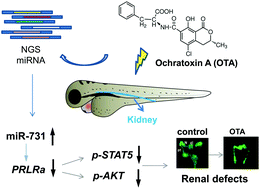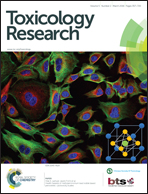Mycotoxin ochratoxin A disrupts renal development via a miR-731/prolactin receptor axis in zebrafish†
Abstract
Mycotoxin ochratoxin A (OTA) frequently contaminates various food and feed products, including cereals, coffee and wine. While the nephrotoxicity and teratogenicity of OTA have been extensively documented, the molecular mechanisms associated with OTA toxicity remained poorly understood in a developing organism. We showed that zebrafish embryos exposed to OTA demonstrated incorrect heart looping and small heart chambers. OTA also impaired the renal morphology and reduced the glomerular filtration rate of the embryonic zebrafish. The treatment of embryos with OTA attenuated the expression of the prolactin receptor, a gene (PRLRa) that has a key role in organogenesis and osmoregulation in vertebrates. OTA not only inhibited the phosphorylation of STAT5 and AKT, but also down-regulated the level of serpina1 mRNA in a dose-dependent manner. On the other hand, the microRNA profiling based on RNA sequencing revealed the up-regulation of microRNA-731 (miR-731) in the OTA-treated embryos. Further in silico analysis predicted that PRLRa was a target gene of miR-731. AntagomiR-731 restored PRLRa levels that had been reduced by OTA and also recovered the pronephros morphology that was damaged by OTA. These observations suggest that the exposure to OTA adversely affected the organogenesis of zebrafish, and the modulation of miR-731 and the PRLR signaling cascade contributed to the abnormal renal development mediated by OTA.


 Please wait while we load your content...
Please wait while we load your content...